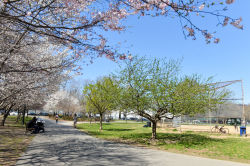McCarren Park
McCarren Park
McCarren Park is located in the Williamsburg and Greenpoint neighborhoods of Brooklyn. The park is named for Patrick Henry McCarren (1849-1909), a popular Democratic politician of the late 19th Century. McCarren was born in East Cambridge, Massachusetts to Irish immigrants. He later moved to Williamsburg, where he attended school and learned the cooper or barrel-making trade. He went on to work in sugar refineries along the waterfront and eventually became a lawyer. He began his political career at the age of 21 and quickly rose through the ranks of the Brooklyn Democratic Party to win election to the State Assembly in 1881 and the State Senate in 1889. In 1909, the Board of Aldermen re-named the park, formerly Greenpoint Park, in his honor.
At the turn of the century, the area around the park was largely industrial, with chemical, varnish and iron works, and braid factories. The four parcels that became the park were acquired by the City of New York between 1903 and 1905. Two playgrounds with outdoor gymnastic equipment were developed almost immediately: one for boys at the corner of Bedford and North 14th Streets and one for girls at the corner of Manhattan and Driggs Avenues.
In 1910, the park installed modern athletic facilities, including a ¼-mile track, a field that became an ice rink in winter, tennis courts, a dancing platform, play equipment for small children, and baseball, football, and soccer fields. By the late 1920s, the track was used not only for running but also for bike races, and the tennis courts hosted annual borough-wide tournaments that attracted as many as 5,000 spectators.
McCarren also served as Brooklyn’s first children’s farm, which opened in 1914. During its first season, 240 “little farmers” tended 120 individual plots nurturing radishes, beets, carrots, beans, onions, lettuce, and corn. In the winter, the “Farm House” shelter became a social center for local clubs and church groups.
In August, 1936, a state-of-the-art swimming pool opened in the park, one of eleven built throughout the city that summer courtesy of the Works Progress Administration (WPA). The WPA was created during the Great Depression as part of President Franklin D. Roosevelt’s New Deal, and provided work to unemployed Americans who were tasked with building large public infrastructure projects across the United States. Mayor Fiorello LaGuardia dedicated the new recreation facility on July 31, 1936, before a crowd of 75,000 jubilant Greenpoint residents.
Designed by architect Aymar Embury II, McCarren Park Pool was second in size only to the Astoria Park Pool, and distinctive for its soaring arches and dramatic scale—typical of the heroic architecture of the era. With a capacity of 6,800 swimmers, the pool quickly became the summertime social hub for the community.
By 1984, however, the pool had to be closed due to deterioration. In 2005, it was finally resurrected, first as a performance space and later as a music venue for high-profile concerts. In the summer of 2008, NYC Parks began a major restoration that included not only the outdoor Olympic-sized pool, but also a year-round recreation center, and the historic bathhouse building and entry arch. Designed by Rogers Marvel Architects, the project was part of PlaNYC, a sustainability initiative designed to renovate eight large parks in underserved communities in all five boroughs.
The pool re-opened in summer 2012 with capacity for 1,500 swimmers. The following year, a concrete plaza called ''the beach'' was transformed into northern Brooklyn's first public ice-skating rink and is now operated by the nonprofit Open Space Alliance for North Brooklyn. In June 2016, NYC Parks also premiered a new McCarren Skatepark, whose re-design was shaped by local and professional skateboarders and features quarterpipes, ledges, hips and rails.
Several areas within McCarren Park are named for local heroes who died in the line of duty. These include T. Raymond Nulty Square (World War I soldier), Patrolman Stephen Gilroy Field (police officer), and Father Jerzy Popieluzsko Square (Polish priest martyred by the Communists). A captured German cannon from World War I once stood in the center of the park, but was melted down as scrap for World War II.
For generations, neighborhood residents and park advocacy groups have mobilized community support for the park’s maintenance and improvement. Through their efforts, McCarren Park has remained a vibrant social and recreational hub.
Check out your park's Vital Signs
Clean & Safe
Green & Resilient
Empowered & Engaged Users
Share your feedback or learn more about how this park is part of a
Vital Park System










